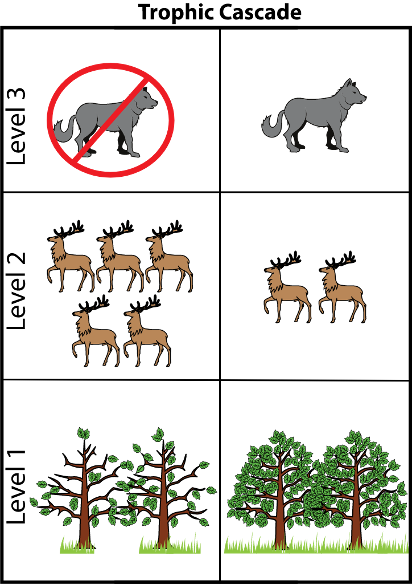By Whitney Bell
The United States has 62 National Parks. Some of the most famous and most visited include Great Smoky Mountains, Grand Canyon, Yosemite, and Zion National Parks. Yellowstone National Park, created by President Ulysses Grant in 1872, was the country’s very first national park. National Parks are popular tourist destinations because of their natural beauty, unique landscapes, and abundant wildlife. These protected areas of land help preserve important and endangered species, as well as a variety of ecosystems.
An ecosystem is defined as the living organisms (biotic factors) and physical environment (abiotic factors) in an area that interact and function together as a unit. Ecosystems change over time due to natural disasters, changes in climate, human activities, and predation. These activities can alter the landscape and species composition of the area.

One of the most interesting examples of an ecosystem alteration involves gray wolves and Yellowstone National Park. After Yellowstone’s creation in 1872, the federal government feared that the wolves living in the protected park area would kill livestock on surrounding ranches as well as herds of elk and bison. Their solution was to create a program to eradicate the wolf population, and by 1924, the last known Yellowstone wolves were killed. This resulted in a trophic cascade, a phenomenon that occurs when a top predator is removed or added, causing dramatic changes in predator and prey populations through the food web and altering ecosystem structure, kind of like a domino effect.

Without their natural predators, the wolves, the elk population skyrocketed. The elk overgrazed plants and caused drastic loss of young trees, such as aspens and willows. This was especially true in areas bordering bodies of water, known as riparian zones. Sprouts and young trees, called seedlings, were consumed before they could grow into larger, more mature trees. This decline in tree growth affected species such as beavers, which need trees to build their dams that serve as their homes where they raise their young. Loss of trees also affected bird populations that need trees to build their nests and other animals that rely on plants and trees for shelter and food. Rivers and streams no longer had plant roots to stabilize the soil of their banks, which led to erosion. These may all sound like small changes, but combined over decades, the loss of wolves greatly affected many components of Yellowstone’s ecosystem.

In 1995, nearly 70 years after eradication of gray wolves in Yellowstone, they were reintroduced in an attempt to restore Yellowstone’s ecosystem. More wolves were introduced in 1996 and 1997, and the reintroduction program was a success. In 2015, it was estimated that 528 wolves live in the Greater Yellowstone Ecosystem (which includes the vast area surrounding Yellowstone), and in 2020, at least 94 wolves across 8 packs were recorded in the park itself.
With the reintroduced wolves hunting and controlling the elk populations, the aspen and willow populations have had a chance to recover and grow because there are fewer elk eating them. With increased seedling growth, there is more food and shelter for other species, like the beavers. Increased numbers of beaver dams help control water flow and runoff as well as provide shelter for fish and insects. Riparian areas have stabilized due to the increased root growth and lessened soil erosion. Wolf predation also keeps elk herds moving so the elk aren’t staying in one area too long and overgrazing the vegetation. These are just some of the examples of how wolf reintroduction changed the Yellowstone ecosystem!

When a plant or animal has a largely disproportionate effect on the ecosystem, it is called a keystone species. Our Yellowstone example illustrates why wolves are considered a keystone species. Seemingly subtle changes can have a big effect on an ecosystem, which is why it is important to do our best to maintain and preserve them. Ecosystems such as rainforests, coral reefs, and savannahs have already suffered greatly due to human activities. Can you think of current threats they face or a keystone species that might have been affected in those ecosystems?
